维多利亚时代英文介绍
维多利亚时代【英文】 victorian period
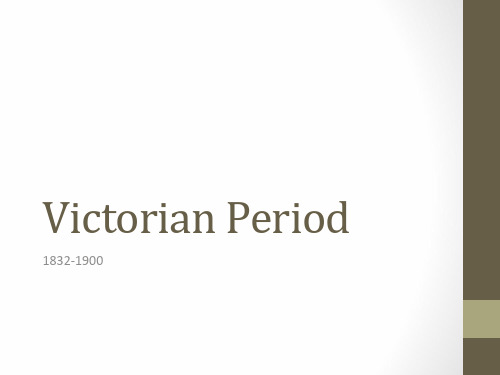
Victorian Period
• Women for suffrage – did not succeed until 1918 (30 & over) • Universal adult suffrage 1928 extended vote to women at age 21 • Factory Acts – limited child & women labor • State supported schools est. in 1870; compulsory in 1880; free in 1891 • Literacy rate increased from 40% to 90% from 1840-1900.
• First Reform Bill in 1832 extended vote to all men who owned property worth 10 lbs • Second Reform Act in 1867 gave the right to vote to working-class men (except agricod
• Intellectual Progress
• Understanding of earth, its creatures & natural laws (geology, Darwin – theory of evolution) • Industrialization of England depended on and supported science and technology.
Victorian Period
• Paradox of progress
• Victorian – synonym for prude; extreme repression; even furniture legs had to be concealed under heavy cloth not to be “suggestive”
Victorian Era 维多利亚时代

TYPICAL INCOMES (YEARLY)
Aristocrats £30,000 Merchants, bankers £10,000 Middle-class (doctors, lawyers, clerks) £300-800 Lower middle-class (head teachers, journalists, shopkeepers, etc.) £150-300 Skilled workers (carpenters, typesetters,etc.) £75100 Sailors and domestic staff £40-75 Laborers, soldiers £25
19TH CENTURY ENGLAND
THE INDUSTRIAL REVOLUTION
It accelerated the migration of the population from country to overcrowded c 1876 the telephone was invented by Alexander Graham Bell The radio was invented in 1895 by Guglielmo Marconi. The camera, toilet, sewing machine, vacuum, train and stamp were all created during the Victorian Era. Factories began to be powered by steam. The police force was created during this period.
Great Expectations
维多利亚时期背景介绍THE VICTORIAN AGE
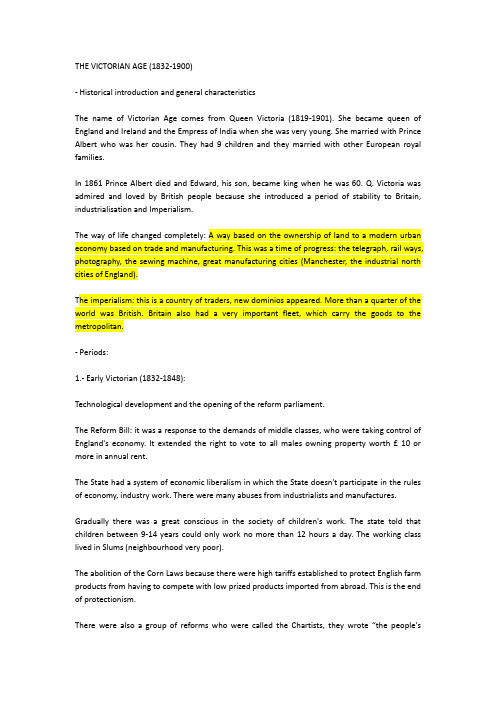
THE VICTORIAN AGE (1832-1900)- Historical introduction and general characteristicsThe name of Victorian Age comes from Queen Victoria (1819-1901). She became queen of England and Ireland and the Empress of India when she was very young. She married with Prince Albert who was her cousin. They had 9 children and they married with other European royal families.In 1861 Prince Albert died and Edward, his son, became king when he was 60. Q. Victoria was admired and loved by British people because she introduced a period of stability to Britain, industrialisation and Imperialism.The way of life changed completely: A way based on the ownership of land to a modern urban economy based on trade and manufacturing. This was a time of progress: the telegraph, rail ways, photography, the sewing machine, great manufacturing cities (Manchester, the industrial north cities of England).The imperialism: this is a country of traders, new dominios appeared. More than a quarter of the world was British. Britain also had a very important fleet, which carry the goods to the metropolitan.- Periods:1.- Early Victorian (1832-1848):Technological development and the opening of the reform parliament.The Reform Bill: it was a response to the demands of middle classes, who were taking control of England's economy. It extended the right to vote to all males owning property worth £ 10 or more in annual rent.The State had a system of economic liberalism in which the State doesn't participate in the rules of economy, industry work. There were many abuses from industrialists and manufactures.Gradually there was a great conscious in the society of children's work. The state told that children between 9-14 years could only work no more than 12 hours a day. The working class lived in Slums (neighbourhood very poor).The abolition of the Corn Laws because there were high tariffs established to protect English farm products from having to compete with low prized products imported from abroad. This is the end of protectionism.T here were also a group of reforms who were called the Chartists, they wrote “the people'scharter” (1838). It was a kind of people rights. They asked for a Universal Manhood suffrage.2.- Mid Victorian (1848-70):Because of the new inventions this is a period of prosperity (agriculture, industry...). in 1851 was “The Great Exhibition” in the Chrystal Palace, London. It shows the new inventions and congratulations of English empire.In this period there were a confrontation of ideas:Utilitarianism: it is a theory based on the idea that the rightness or wrongness of an action is determined by whether its consequences are conductive to general utility. The main thinker was Jeremy Bentham (Wrote about social happiness. He believed that individuals acted by self-interest). The utilitarians applied this idea for all the institutions, for everything.Opposed to the utilitarianism: Thomas Carlyle, he thought that intellect had limitations and couldn't explain everything and he turned to the humanism soul, a sort of religious belief was necessary to explain things.It was a group of writers who were shocked for the condition of living in some parts of England and they wrote a series of novels, “condition of England Novels” they were about living in the slums and they critiqued the oppression of working class.Elisabeth Gaskell´s “North and South” and Benjamin Disraelis “Sybil of the two nations”3.- Late Victorian: (1870-1900):The U.K. had more competitors in trade, e.g. The United States and Germany which was becoming an empire.It is a period in which workers began to join in associations, which are called trade unions. The first workers who went together were miners and textile workers. A very important association until today is called The Trade Union Congress (1868), which is the assembly of all the associations. From here we have an order of workers and a political party, Labour Party (1906)GENERAL CHARASTERISTICS OF VICTORIAN LITERATURE1. - Prose: The beginning of a new kind of prose, the lyric prose, is a prose that not only communicate ideas, it express it beautifully. In this time the readers wanted for advice from authority and some writers provided advise, people needed a guide. E.g. Thomas Carlyle, John Henry Newman, Mathew Arnold. It's full of prepositions because of this didactic style and parallelisms.2. - Poetry: It was considered superior than prose, novel theatre. They said that the writing of agenius must be poetry. There were two main romantic inheritances in poetry:1.- the use of retrospective forms: archaic language. They revived many old forms (particularly the mixture of lyric and elegy which influenced others forms like epigram).2.- experimentation with genres. Some poets continued the movement of colloquial diction into poetry (Robert Browning)3. - Novel: The main theme is man in society (family, business, friends...). they don't speak abut the past, speak about things that were happening in that time. (Dickens, Brontës).4. - Drama: Theatre had a little importance (Oscar Wilde, George Bernal Shawn)THE BRONTËS- Charlotte Brontë (1816-1855)- Emily Brontë (1818-1848)- Anne Brontë (1820-1849)Their father, Patrick Brontë was a clergyman in Yorkshire. He had six children, his mother died very soon. The four eldest were sent to a boarding school. The two eldest died of tuberculosis so the four children that remain were educated at home.He encouraged the children to learn by their own. Mr Brontë discussed poetry, history and politics with his children. The children themselves created a world of fantasy. Mr. Brontë gave his son a book of wooden soldiers, the soldiers became for them the centres of an increasingly elaborate set of manuscripts. They created new countries like Angria, Gondal. They wrote little novels of these imaginary countries.They worked as teachers and governess and they wanted to set up their own school. They wen to Brussels to study language.Branwell (the brother) was a very talented as a writer and painter, he took drugs and alcohol and died in 1848. In the funeral Emily caught a cold and it developed into tuberculosis and died in December, a year late Anne also died.- Charlotte Brontë: “Jane Eyre”, the novel examines many sides of the circumstances of women show a new move towards freedom ad equality.- Emily Brontë: “Wuthering Heights”, it is a novel of passion, an early psychological novel.- Anne Brontë: “The Tenant of Wildfell Hall” With an unusual central female character andinvolving complex relationships and problems.CHARLES DICKENSHe was born in the south of England, his father was a clerk, he went to prison and Dickens had to work in a factory (blacking workhouse) when he was 12 years old. He lived in different parts of London and knew poverty and London slums. He used this material in his novels.He became a reporter, he worked in many magazines and published in one of these magazines several sketches of the life and manners of the time these were together in one volume “Sketches by Boz”.He was asked to write “The Pickwick Papers” in 20 monthly numbers. He published his novels by instalments, he had to maintain the interest of the readers in order they want to read the following chapters. While he was writing the novel knew how was the reaction of the people, what people preferred and he could change the direction of the novel. Many critics think that the novels published in this way have a loose structure.He got married Catherine Hogarth, they had ten children, the couple separated because he had an affair with an actress. He went to America twice making them read his novels. He left his last novel unfinished.Sentimental work:- “Oliver Twist” (1837-38): it shows a great concern about social problems. He had very strong opinions against the factories in which children worked. It is a story of a poor boy that worked in a factory and describes his situation. He went away and discovered a band of thieves who taught him to be a thief. The novel is a mixture of melodrama and realism.- “The curiosity shop” (1840-41):This is the story of little Nell, a girl who lives with her grandfather. Her grandparent borrows money to a miser who takes the shop because he can't pay. They have to go away because the miser persecuted them.- “A Christmas Carol”: Scrooge a very bad miser received the visit of 3 ghosts which show past, present and the following Christmas and showed how bad he is.- “David Copperfield” (1949-50): The hero David, becomes the kind of success which Victorians admired, he is rich, he marries, and a general sense of happy ending is given. This novel was based in part of Dickens's own childhood and his success.Works after 1850:- “Bleak house”: it is a satire of the delays of law. It's a process which never ends.- “Hard Times”: it is an attack on capitalism, society and industrial life.- “A Tale of cities”: historical novel on the French revolution.- “ Great expectations”: it is about an orphan who has a secret benefactor. He help a prisoner to escape, the convict later helps him.General characteristics:He saw the world as a fresh experience. He had an extraordinary range of language, he could use colloquial and formal language. Great characters and intense emotionalism.THOMAS HARDY: “Far for the Madding Crowd”The tittle comes from the poem “Elegy written in a country churchyard”. It was published in 1874 in a magazine in serial form. He had to write in the way the readers wanted to know what was going to happen in the next chapter. It had a great success. When it was published he was 33 years old and it was his 4th novel.All Hardy's novels are settled in Wessex (the south west of England where there are a lot of counties, it is an imaginary noun).Hardy was very pessimistic and the main theme of his novels is the struggle of man against the indifferent forces that rule the world, his novels are tragic.In the first chapter, there is an introduction of the two main characters: Gabriel Oak and Bathseba; it is located in the countryside, rural setting.The narrator is omniscient, he controls everything. They are confident, they are sure of them. He goes through the novel controlling the novel, he could also change the point of view.Man in society is the main characteristic of Victorian novels. Gabriel is seen from the point of view of others.The basic idea is that he was just an ordinary man: Hardy conveys these ideas offering images of behaviour.GEORGE ELIOT (1819-1880)Her name was Mary Ann Evans, she used a pseudonym for his publications. She was born in the Church of England. At the school she converted into Methodism, which is very strict in words. She was a very cultivate woman, she was agnostic because of her intellectual formation. She translated religious texts and the critic about it. She was strongly influenced by religious concepts of love, morals, duty and behaviour.She became the assistant editor of a magazine, “The Westmister Review”. She felt strongly in love with the editor but this love was not reciprocated. Later she felt in love with Herbert Spencer but again this relation didn't go well. She met another writer G.H. Lewis, they felt in love and they went to live together until Lewis' death(1878). When he died she married her financial adviser (two years later) and seventeenth months later she died.Works:She translated many religious books. She knew Italian, German... she translated Feverbach's “Essence of Christianity”. It is important because she agreed with Feverbach view that religious beliefs are an imaginative necessity of man and a projection of his interest.Her novels were published by instalments. She has been considered the first modern English novelist.In the first generation the writers considered themselves as providers of advise and public entertainers. They wrote books to enjoy and offer them some advice. The new writers of the second generation took their job very seriously, they considered themselves as novelists, professional writers.Eliot takes her works seriously as novelists, the structure has to be perfect. She was a moral writer in the sense that she believed that the responsibility for a man's life and fate lay firmly on the individual and his moral choices. The individual has to decide in every situation and has the responsibility of his life. But the individual decisions are not external.She wrote: “Adam Bede”, “The Mill on the floss”, “Silas Marner”, “Romola, “Felix Holt”, “Middlemarch”, “Daniel Deronda”.We can represent her novels in two circles:“Middlemarch”: It was published in a serialised for. It is considered a masterpiece. The tittle is the changed name of a city where the action happens, Middlemarch is the provincial of Coventry. This novel is set during the years of the 1st reform bill. It has a multiple plot, with many arguments, several interlocking sets of characters, so she created a network that enclosed the whole life of this city.One of the stories is the story of Dorothea Brooke and Mr. Casaubon. She is an intelligent idealistic young woman and married Mr. Casaubon (a pedant). She wants to share her husband's world. When she married she realized that her husband has plans but didn't worked at them, she loses the respect of him. She begins to fell in love with Ladislaw.Another history is Dr. Lydgate, a young and very ambitious man who had plans, he wants to stablish professionally. A very beautiful woman plans to marry him, her name was Rosamand.They married but it didn't go well because she is materialist and selfish. He gets involved in some problems. In a determined point, Dorothe sees Rosemand and Ladislaw together and she decides not to love him.All the characters Know each other, at the end all the plots have relation between them, it makes a perfect portrait.THOMAS HARDY (1840-1928)He was born in Dorchester. His father was a stonemason and he worked as an apprentice to several architects, learning the profession. He began to write poetry and in the period of 1870-3 he published his first three novels, his great success came with his fourth novel, “Far from the Madding Crowd” (1874). Then he left architecture for novel writer. The most important novels that he published are “The return of the native” (1878), “The major of Casterbridge”(1886), “Tess of the D'urbervilless” (1891), and “Jude de Obscure” (1896).He became a very well known figure in London. His works were very tragic. The critics criticised his two last novels, they said that they were very immoral and pessimistic and because of this he abandoned the fiction novels and wro te only poetry, such as “Wessex Poems” (1898). He called himself “meliorist” and said that the world could be better by human effort. He received a honorary degree from Cambridge University.Work:The main theme is the struggle of man against the indifferent forces that rule the world: how people suffer because of fate who are more powerful than him. The disparity between the things that people wanted to be and the things that actually they are, between human ambition and fate. The fate is completely eternal and is important, also the social conditions.The characters are not the masters of their own fate but they can achieve dignity by endurance. He offers some sense of human in the description of rural characters.“Wesssex” is the name he gave to the south west of England. He changed the names of the places, the villages are real but the name is invented.“Tess of the D'urbervilless” : Tess is a country girl who is seduced by Alec, a rich young man, she gets pregnant and Alec leaves her. The child dies so she is very miserable, she has to work as a maid. She meets another man, angel, who is the son of a priest and they married. In the wedding night, Tess told about Alec and Angel abandoned her.Tess has to accept to become the mistress of Alec because of her bad situation. Angel returns to look for his wife, but Tess and Alec are living together. Tess gets mad and kills Alec. She is hung because of this.OSCAR WILDE (1854-1900)He was born in Dublin. His father was a very famous surgeon and his mother was a very well known poetess in Dublin. She was very controversial, provocative, excentric and Oscar had her influence. He was very estrange physically: tall, fattish, big dreamy eyes, too fleshy, big mouth, at the same time he was beautiful and awful. He dressed extravagantly because he didn't feel ashamed of his appearance.He learnt from his mother how to be funny courageous and he was a transgressor (to break the rules of society). He went to Oxford and he was a very good student. He caught syphilis from a prostitute. At the age of 29 he married Constance Lloyd. They had 2 children but soon Constance was a very sexual object for him. He convinced his wife to stop having sexual relationships, but they continued living together.By this time he wrote books of poems, tales, fairy stories. He was an excellent conversationalist, he speaks beautifully, funny, witty. Some writers said he looked like disgusted at first impression. Under this image, superficial, trivial, he was transcendent, he belonged to a poetical movement called Aestheticism whose motto is art for art sake.In 1891 Oscar met Lord Alfred Douglas (Basic) who was 21 years and Oscar 37. Basic was a young rich selfish, conceited, frivolous, cruel man. Oscar felt in love desperately in love with basic, who introduced him to the world of underground and make Oscar's life very awful. Oscar tried to leave him but he couldn't because he loved him and Bosie threatened Oscar to suicide if Oscar left him. Bosie's father was the marquis of Queensberry, he knew the relation between them and they became enemies.Meanwhile Oscar published his only novel “The portrait of Dorian Gray”, is a sort of gothic novel. Dorian wanted to be young forever. He wanted to try forbidden things.The real success came with his plays: “Lady Wardermere's fan” (1892); “A woman of no importance (1893); “An ideal husband” (1895); “The importance of being Earnest” (1895). ð Witty, funny, word plays, paradoxes.15 days after the streno of the last play Bosies's father left a note in Oscar's club accusing him of being sodomite. Oscar didn't want to answer. Bosie told Oscar to take his father to court because of difamation. The case was a hopeless case, because during the trial all the things they had done appeared and Oscar was arrested and taken to a jury. During this second case all the people he had met in the underground come to the court and told all the things they had done.He was sent to prison. Two years of force labour and his name was a matter of shame. His novels were retired of libraries; his novels never were represented again. His wife changed her surname and her child's. After 2 years he was a broken man and his friends took him to France. Oscar accepted to see Bosie again, who left him when discovered that Oscar didn't write and had lost his glamour.“The Ballad of Reading Gaol” (1898) about his prison experience.The last work published after his death “De Profundis” (1905) is a letter to reproche to Bosie, a confession.ALFRED, LORD TENNYSONHe is the Victorian poet, he wrote the model of Victorian poetry. Queen Victoria was an admirer. She was a widow for 40 years and found consolation in Tennynson's poetry. He is the poet of love and loss.His father was a priest, he was the fourth of twelve children. Their father taught them privately: classical language, philosophy, reading. He went to Cambridge and became friend of a group of artists and writers. One of them was Arthur Hallan, who was his confident, adviser, closest friend. He became engaged Arthur's sister, but died at the age of 22 and this provoqued a great depression in Tennynson, it was the origin of the poem “In Memorian” (1850)Before 1850 he had written many books of poems although they didn't became famous. He became Poet Laureate; before this publication he had the recognition of his works and it gave him a lot of money.Works:“Poems, chiefly lyrical” (1830); “in Memorian” (1850);“The charge of the light Brigade”(1854): it is inspirited on a piece of news on the newspaper about the soldiers who died in the Crimean War.“Maud” (1855): It is a monologue and best seller“Idylls of King” (1859): It is about King Arthur.General characteristics of his literature:Great virtuosity of technique. He studied the poetry of his predecessors and achieved a great technique.He had a great capacity to link scenarios to states of mind. His vision of nature is not idealistic as romantics. He prefers rural things rather than urban.Preoccupation with the problems of his days: about technological changes, he thought that it was positive but he was very worried because of horrors of industrialism (slums, working conditions, working of the children).He was an admirer of Yeats.“In Memorian”He started it in 1833. It is a series of poems put together around the same theme: the death of his friend. More than an elegy is a group of poems about anxieties and doubts about the meaning of life, what a rule of a man was in the world and doubts because of the death of his friend. It is a poet diary upon his reflections on this matter.ROBERT BROWNING (1812-1889)/ ELISABETH BROWNING (1806-1861)Robert is admired for two things:moral toneinnovations in poetry- Robert browning was born in London, he was the son of a banker, and educated basically at home because his father had a great library and he read a lot.At the beginning he wrote personal poems. Some critics attacked his poems and he was embarrassed because of this, so he changed his way of writing( very personal), which became more obscure.After 1936 and during ten years, he wrote plays but without success, but it was a good practice for a new model of poetry which he developed; dramatic monologue. It was his best known kind of poetry because he could write in a personal way under a character.“Dramatics Lyrics” (1842) it was the first collection of this kind of poetry.After 15 years in Italy, he and his son came back to England. He wrote “Dramatis Personae” (1864) which was a monologue; “The Ring and the Book”.- Elizabeth was a very well known poet who was semi-invalid, under the control of her father. She was kept at home, she had a tyrannical father, she was very well educated.She published “Poems” (1844) and Robert read it and enjoyed it very much and they stablished a correspondence. After a time they became engaged secretly. In 1846 they got married secretly and eloped to Italy and stayed there for 15 years. There she discovered that she wasn't invalid and they were very happy. The product of their love is “ Sonnets from the Portuguese” (1850): a sequence of forty four sonnets in which she recorded the stages of her love for Robert Browning, a sequence she presented under the guise of a translation from the Portuguese language.“Aurora Leigh”(1857)Differences between Browning and TennysonTennyson was the Victorian poet who was worried with the topics of the age. But he explored the topics of the day in a different way: faith/doubt, Good/evil.The main difference is the style. Tennyson belonged to the lyrical tradition. Browning had a more colloquial, prosaic tone, his poems are like prose.The social world within which this dilema has to be resolvedThe centre of her novelsA small group of individuals involved in a normal dilema。
维多利亚时代简介(权威英文版)

4. often have happy ending or an important compromise to current society 5. So far as the literary form or genre is concerned, the major contribution made by the 19th century critical realists lies in their perfection of the novel.
George Eliot (Mary Ann Evans) • Silas Marner • Middlemarch
Emily Bronte Charlotte Bronte
Thomas Hardy
Victorian Poetry
Always seems inferior when compared to Romanticism Develop new ways to tell stories—e.g. dramatic monologue Do not share Romantics’ confidence in the imagination Emphasis on visual imagery and sound
Critical Realism
A realistic presentation of the sufferings of the working class, to the criticism of English institutions, and to the education of the masses.
The Victorian Period (维多利亚时期)
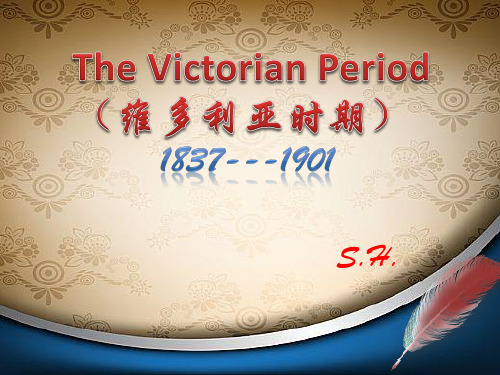
Features of Dickens’ Novels 狄更斯文学创作的特色
Sharp social criticism. 尖锐的社会批评 Gentle humanitarian. 温和的人道主义 vivid outward portrayal 生动的人物塑造 Humorous and Pungent irony 幽默辛辣的讽刺
• The best he can do seems to try to retain an optimism with wishful thinking, as in his early works, or to express a helpless indignant protest. At the same time, he hopes to call people‘s attention to the existing social problems, thus affecting some reform。
of cites《双城记》
译文:
那是最美好的时代,那是最糟糕的时代; 那是智慧的年头,那是愚昧的年头;那 是信仰的时期,那是怀疑的时期;那是 光明的季节,那是黑暗的季节;那是希 望的春天,那是失望的冬天;我们拥有 一切,我们一无所有;我们全都在直奔 天堂,我们全都在直奔地狱。
• He lies buried in the Poet’s Corner in London. • The words of his grave read as follows ”by his death one of England’s greatest writers is lost to the world.”
Oliver Twist
英美Chapter 5 维多利亚的时代

Chapter 5: The Victorian Period (维多利亚时代)part 1 Historical Background➢Time Span (para.1, p156)1837-1901 to coincide with the reign of Queen Victoria(维多利亚女王的统治时期)➢Victorian Period can be divided into 3 parts/stages:The early Victorian period(早)The mid-Victorian period(中)The late Victorian period(晚)Victorian Period is an extremely diverse and contradictory age. (para.1, p156)维多利亚时代是一个极其多样化和矛盾的时代。
imperial expansion, political reform, scientific progress帝国扩张,政治改革,科学进步Cruel exploitation, social injustice, desperate poverty残酷的剥削,社会不公,极度的贫困It was an age of “paradise for the well-to-do, a purgatory for the able, and a hell for the poor. 那是一个富人的天堂,能人的炼狱,穷人的地狱的时代。
-John Morley 早期的维多利亚时代(para.2, p156)1.Industrial Revolution (工业革命)→introduction of coal & steam engine(煤和蒸汽机)→transportation --> world trade market(运输—世界贸易市场)→profound economic & social changes(深刻的经济社会变革)2.Industrial Revolution (工业革命)→make up a new kind of working class(组成了一种新的工人阶级)→horrifying slums & cramped row housing(可怕的贫民窟和拥挤的排屋)→A huge gap between the rich and the poor(贫富之间的巨大差距)3. THE REFORM BALL of 1832 (议会通过选举改革法案)①It extended the voting rights to the men of the middle class.它扩大了中产阶级男性的投票权。
维多利亚时代文化英语介绍
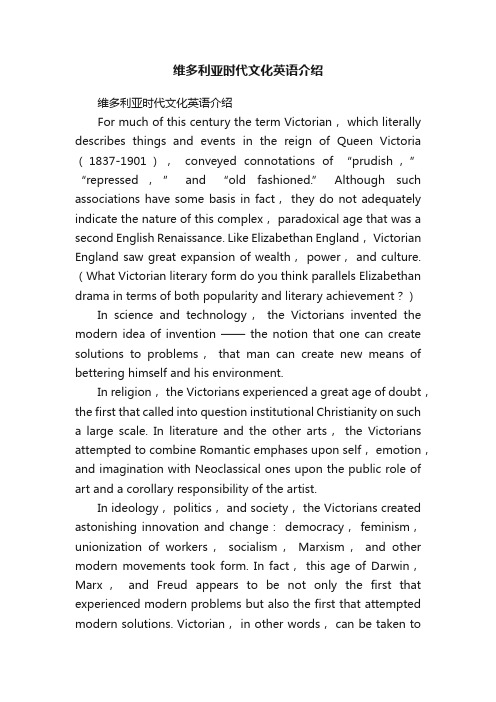
维多利亚时代文化英语介绍维多利亚时代文化英语介绍For much of this century the term Victorian, which literally describes things and events in the reign of Queen Victoria (1837-1901),conveyed connotations of “prudish,” “repressed,” and “old fashioned.” Although such associations have some basis in fact, they do not adequately indicate the nature of this complex, paradoxical age that was a second English Renaissance. Like Elizabethan England, Victorian England saw great expansion of wealth, power, and culture. (What Victorian literary form do you think parallels Elizabethan drama in terms of both popularity and literary achievement?)In science and technology,the Victorians invented the modern idea of invention ——the notion that one can create solutions to problems,that man can create new means of bettering himself and his environment.In religion, the Victorians experienced a great age of doubt,the first that called into question institutional Christianity on such a large scale. In literature and the other arts,the Victorians attempted to combine Romantic emphases upon self, emotion,and imagination with Neoclassical ones upon the public role of art and a corollary responsibility of the artist.In ideology, politics, and society, the Victorians created astonishing innovation and change:democracy,feminism,unionization of workers,socialism,Marxism,and other modern movements took form. In fact,this age of Darwin,Marx,and Freud appears to be not only the first that experienced modern problems but also the first that attempted modern solutions. Victorian, in other words, can be taken tomean parent of the modern —— and like most powerful parents,it provoked a powerful reaction against itself.The Victorian age was not one,not single,simple,or unified, only in part because Victoria's reign lasted so long that it comprised several periods. Above all, it was an age of paradox and power. The Catholicism of the Oxford Movement,the Evangelical movement, the spread of the Broad Church, and the rise of Utilitarianism, socialism, Darwinism, and scientific Agnosticism,were all in their own ways characteristically Victorian; as were the prophetic writings of Carlyle and Ruskin,the criticism of Arnold, and the empirical prose of Darwin and Huxley;as were the fantasy of George MacDonald and the realism of George Eliot and George Bernard Shaw.More than anything else what makes Victorians Victorian is their sense of social responsibility, a basic attitude that obviously differentiates them from their immediate predecessors,the Romantics. T ennyson might go to Spain to help the insurgents, as Byron had gone to Greece and Wordsworth to France;but Tennyson also urged the necessity of educating “the poor man before making him our master.” Matthew Arnold might say at mid-century thatthe world,which seems T o lie before us like a land of dreams,So various, so beautiful, so new,Hath really neither joy, nor love, nor light,Nor certitude, nor peace, nor help for pain.but he refused to reprint his poem “Empedocles on Etna,” in which the Greek philosopher throws himself into the volcano,because it set a bad example;and he criticized an Anglican bishop who pointed out mathematical inconsistencies in the Bible not on the grounds that he was wrong,but that for abishop to point these things out to the general public was irresponsible.。
维多利亚时代【英文】
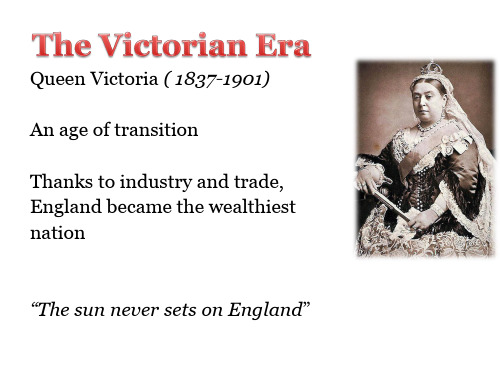
Children and crime: Many destitute children lived by stealing and they were seen as threats to society. Something had to be done about them to preserve law and order.
• The housing shortage: Workers wanted to live nearby their working places because it was time-saving. As a result of these demands and overcrowded conditions, the housing became scarce and expensive; therefore, so many people preferred slum-housing.
• Prostitution:Beginning in the late 1840s, major
Queen Victoria ( 1837-1901)
An age of transition Thanks to industry and trade, England became the wealthiest nation
“The sun never sets on England”
• Britain was unchallenged military power • Britain dominated Global trade and expanded as a colonial empire in India, Australia, Africa and Brazil
维多利亚时代是一个怎样的时代
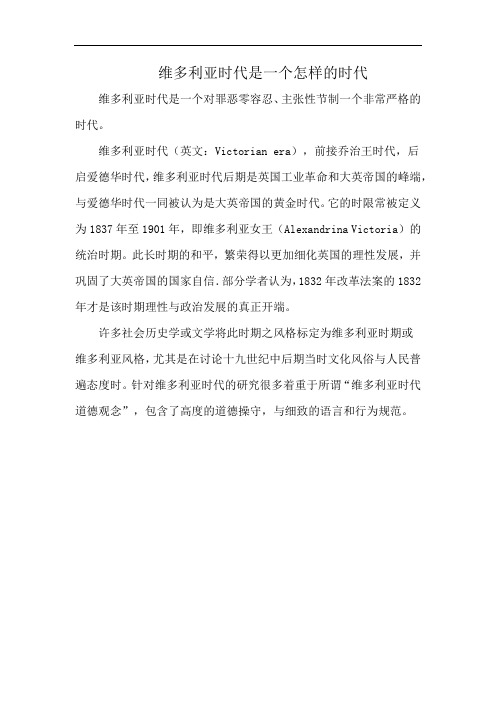
维多利亚时代是一个怎样的时代维多利亚时代是一个对罪恶零容忍、主张性节制一个非常严格的时代。
维多利亚时代(英文:Victorian era),前接乔治王时代,后
启爱德华时代,维多利亚时代后期是英国工业革命和大英帝国的峰端,与爱德华时代一同被认为是大英帝国的黄金时代。
它的时限常被定义为1837年至1901年,即维多利亚女王(Alexandrina Victoria)的统治时期。
此长时期的和平,繁荣得以更加细化英国的理性发展,并巩固了大英帝国的国家自信.部分学者认为,1832年改革法案的1832年才是该时期理性与政治发展的真正开端。
许多社会历史学或文学将此时期之风格标定为维多利亚时期或
维多利亚风格,尤其是在讨论十九世纪中后期当时文化风俗与人民普遍态度时。
针对维多利亚时代的研究很多着重于所谓“维多利亚时代道德观念”,包含了高度的道德操守,与细致的语言和行为规范。
维多利亚时代【英文】
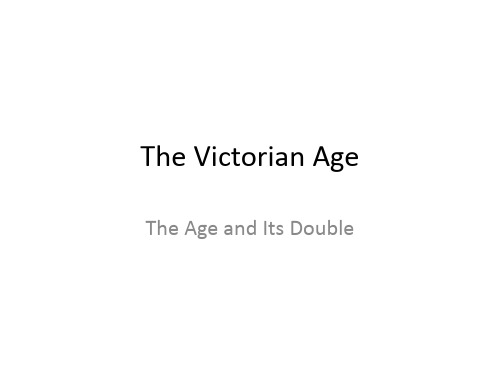
The Age and Its Double
Lesson Outline
• • • • • • • • • • • • • • • • Queen Victoria. Some common ideas about the age. Periodization: Conventional subdivisions. Diversity. Compromise. Contradictions. Victorian values. Poverty, unrest and reform Change and progress The Woman Question. Science. Religion High culture and popular culture. Architecture Art. The genres. The canon. The construction of Victorianism Modernist attitudes regarding the Victorian age and their influence on its construction.
• • • •
•
An Age of Contrasts
• • • • Named by extrinsic facts. Sinterogeneous age. No clear-cut features to characterize it. Actually, an age of contrasts
It was the best of times, it was the worst of times, it was the age of wisdom, it was the age of foolishness, it was the epoch of belief, it was the epoch of incredulity, it was the season of Light, it was the season of Darkness, it was the spring of hope, it was the winter of despair, we had everything before us, we had nothing before us, we were all going direct to heaven, we were all going direct the other way - in short, the period was so far like the present period, that some of its noisiest authorities insisted on its being received, for good or for evil, in the superlative degree of comparison only. Charles Dickens, A Tale of Two Cities
The Victorian Age英国文学维多利亚时期
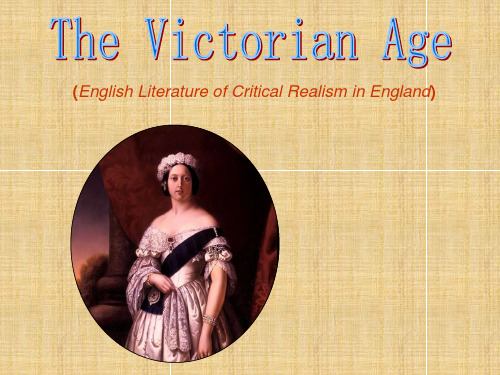
--The 1st Reform Act of 1832 and the 2nd Reform act of 1867 : reform in the electoral system leading to a more democratic society
---,1830, 1850, 1900, Public railway across England and an underground rail system beneath London ---Great Exhibition of 1851 and Crystal Palace (locomotives, machine tools, power looms, reapers, steamboat engines and etc)
huge profit worse living condition workers long-hour working never-adequate food
conflicts
the Chartist Movement
(宪章运动)
What is the Chartist Movement ? 宪章运动
The Victorian age (1832-1901)
◆ Historical Situation An Age of Unrest and Dispute
Social unrest unemployment, poverty, slums in large cites, terrible working conditions; Chartist Movement; petitions for women’s suffrage; the Married Women's Property Acts Intellectual diversity
外研版九年级下册英语英国的维多利亚时代

英国的维多利亚时代
维多利亚时代(Victorian era),前接乔治时代,后启爱德华时代,被认为是英国工业革命和大英帝国的峰端。
它的时限常被定义为1837年~1901年,即维多利亚女王(Alexandrina Victoria)的统治时期。
亦有学者认为,应将通过改革法案(Reform Act 1832)的1832年视为一个新的文化时期的开端。
维多利亚时代被认为是英国工业革命的顶点时期,也是大英帝国经济文化的全盛时期。
在维多利亚时代,财富的分配始终不均,贫富对比十分明显。
一方面,有贵族宫殿式的庄园生活;另一方面,则是农人破败的茅屋草舍。
一方面,是工厂主舒适的生活享受;另一方面,则是失业工人绝望的生存挣扎。
人们的生活水平相差太大,一个国家存在着天堂与地狱的鸿沟。
这一时期英国著名的保守党首相迪斯雷利曾把英国说成是一个“两个民族”的国家,“当茅屋不舒服时,宫殿是不会安全的。
”与之相对应的,是英国人引以为傲的政治制度,包括政府制度、文官制度、司法制度、议会选举制度等,都与时代格格不入。
应该说“光荣革命”后英国建立起的这些政治制度是当时世界上最先进的,不过时过境迁,到了工业革命时期,经济的飞速发展,社会结构的急剧变化,这套制度变得越来越不合时宜,成为强盛之中的一道不和谐的阴影。
06 The Victorian Era
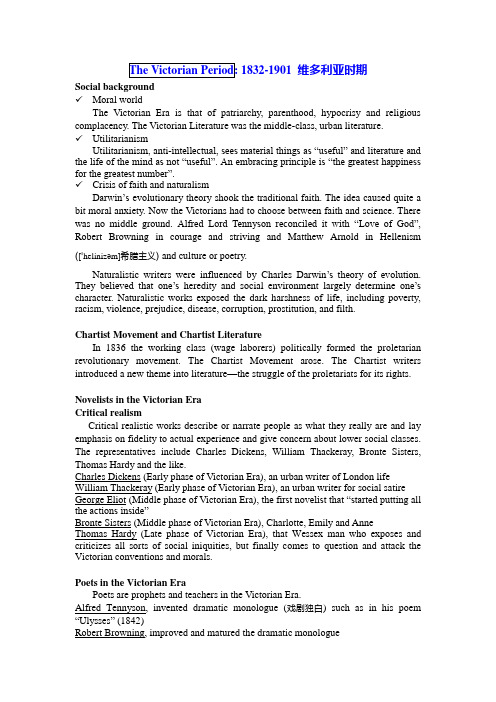
维多利亚时期Social background✓Moral worldThe Victorian Era is that of patriarchy, parenthood, hypocrisy and religious complacency. The Victorian Literature was the middle-class, urban literature.✓UtilitarianismUtilitarianism, anti-intellectual, sees material things as ―useful‖ and literature and the life of the mind as not ―useful‖. An embracing principle is ―the greatest happiness for the greatest number‖.✓Crisis of faith and naturalismDarwin’s evolutionary theory shook the traditional faith. The idea caused quite a bit moral anxiety. Now the Victorians had to choose between faith and science. There was no middle ground. Alfred Lord Tennyson reconciled it with ―Love of God‖, Robert Browning in courage and striving and Matthew Arnold in Hellenism([ˈhelinizəm]希腊主义) and culture or poetry.Naturalistic writers were influenced by Charles Darwin’s theory of evolution. They believed that one’s heredity and social environment largely determine o ne’s character. Naturalistic works exposed the dark harshness of life, including poverty, racism, violence, prejudice, disease, corruption, prostitution, and filth.Chartist Movement and Chartist LiteratureIn 1836 the working class (wage laborers) politically formed the proletarian revolutionary movement. The Chartist Movement arose. The Chartist writers introduced a new theme into literature—the struggle of the proletariats for its rights. Novelists in the Victorian EraCritical realismCritical realistic works describe or narrate people as what they really are and lay emphasis on fidelity to actual experience and give concern about lower social classes. The representatives include Charles Dickens, William Thackeray, Bronte Sisters, Thomas Hardy and the like.Charles Dickens (Early phase of Victorian Era), an urban writer of London life William Thackeray (Early phase of Victorian Era), an urban writer for social satire George Eliot (Middle phase of Victorian Era), the first novelist that ―started puttin g all the actions inside‖Bronte Sisters (Middle phase of Victorian Era), Charlotte, Emily and AnneThomas Hardy (Late phase of Victorian Era), that Wessex man who exposes and criticizes all sorts of social iniquities, but finally comes to question and attack the Victorian conventions and morals.Poets in the Victorian EraPoets are prophets and teachers in the Victorian Era.Alfred Tennyson, invented dramatic monologue (戏剧独白) such as in his poem ―Ulysses‖ (1842)Robert Browning, improved and matured the dramatic monologueMatthew Arnold, a social critic-one of the greatest critical realist writers of the Victorian Age1)child characters 2) horrible and grotesque (怪诞的) characters 3) broadly humorous or comical (可笑的)characters✓characterized by a mingling of humor and pathos (悲伤)✓plot is complex and complicated✓Good will triumph over evil. Benevolence and compassion help a lot.✓As a critical realist he in his novels dealt with debtor’s prisons (Old Curiosity Shop), charity school (Nicholas Nickleby whose publication results in a school reform in England), education of children, workhouses (Oliver Twist), child labor (David Copperfield), cult of money, utilitarianism (Hard Times) and the like✓Masterpieces: David Copperfield (《大卫科波菲尔》), Oliver Twist (《雾都孤儿》或《奥利弗退斯特》),A Tale of Two Cities (《双城记》), Hard Times (《艰难时事》), Great Expectations (《远大前程》)one of the greatest critical realist writers of the Victorian Agewithout a Hero(《名利场》),a satirical novel, gives a panoramic portrait of English society. The book’s title comes from John Bunyan’s allegorical story The Pilgrim’s Progress.in the past.✓Naturalistic and psychological novel 自然主义的和心理分析✓The novels by George Eliot witness individual failure, which is influenced and determined by the combined forces of both individual and society.✓Masterpieces: Adam Bede (《亚当彼德》), The Mill on the Floss (《弗洛斯河上的磨坊》), Middlemarch (《米德尔马契》)Charlotte, is a writer of realism combined with romanticism. Her works are famousthe life of the middle-class working women, particularly governesses.✓Jane Eyre (《简·爱》)It is noted for its sharp criticism of the existing society, e.g. charity institution such as Lowood School.It has successfully introduced to the English novel the first governess heroine, who represents those middle-class working women struggling for recognition of their(《呼啸山庄》)It is a story about 2 families and an intruding (闯入的) stranger.It takes the double perspectives to tell the story, by Nelly and Lockwood.As a love story, it deals with revenge, social forces, natural forces, mixed up with gothic elements.both a naturalistic and a critical realist writer―novels of character and environment‖(性格环境小说): the fictional (虚构的) primitive and crude rural region which is really the home place he both loves and hates.✓Naturali sm plays an important part in Hardy’s works.Man proves impotent([ˈimpətənt]无能为力的) before Fate, however he tries, and he seldom escapes his ordained ([ɔ:ˈdeɪn]规定的)destiny.✓In style, all the works of Hardy are noted for the rustic dialect and a poetic flavor. ✓Masterpieces: Tess, The Return of the Native (《还乡》), Jude the Obscure (《无名的裘德》), Far from the Madding Crowd (《远离尘嚣》)✓T ess of the D’Urbervilles(《德伯家的苔丝》)Tess of the D’Urbervilles is, as the subtitle defiantly sa ys, ―a pure woman,‖ a victimized social heroine of 19th century fiction, trapped between nature and public morality. Tess, as a pure woman brought up with the traditional idea of womanly virtues, is abused and destroyed by both Alec and Angel, agents of the destructive force of the society.―Love of God‖ is an ethical force and man’s redeeming grace.with the feelings.✓In Memoriam ([miˈmɔ:riəm]《悼念》)✓The Idylls of the King ([idil]《国王叙事诗》)is a narrative poem or an epic poem with 12 books, is based on the stories of King Arthur and his Knights of the Round Table.✓Crossing the Bar (《过沙洲》) on the theme of his own death– Efforts and courage help one survive the crisis of faith(《指环与书》) his masterpiece. Its symbolic meaning, the ―ring ‖–the goldsmith’s (金匠的)technique of alloying gold (合金) in making rings. The ―book‖– the hard truthHellenism and culturecritic targeted at middle class: its cultural philistinism ([ˈfilistinizəm]), its idea of progress, its self-serving individualism, and its vulgar and low tastes. He emphasized the role of culture, a social force. He prefers Hellenism (the life of intellect and beauty) to what he calls middle class Hebraism (希伯来主义the life of moral obedience).a literary and artistic movement which flourished in England in the 1880s, devoted to ―art for art’s sake‖ and reject ing the notion that art should have a social or moral purpose. Its chief exponents included Oscar Wilde. It was introduced by Walter Pater ([ˈpeitə]) from Paris to Victorian England.。
维多利亚时期【英文】
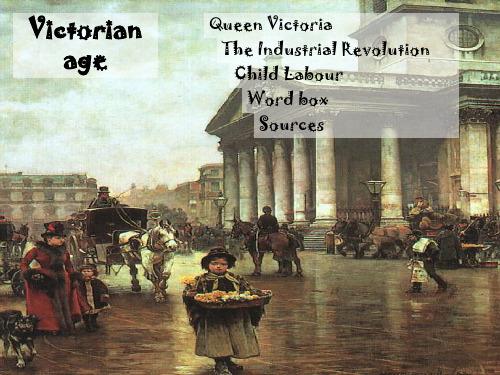
Queen Victoria The Industrial Revolution Child Labour Word box Sources
Queen Victoria
The house of Hanover Queen Victoria
Victoria aged four Victoria (1819-1901) Queen of Great Britain and Ireland and of dependencies overseas (187-1901) and (from 1876) Empress of India. The last of the House of Hanover, she was the only child of George III’s fourth son, Edward, Duke of Kent. She came to the throne in 1837 on the death of her uncle, William IV. She was guided in the performance of her duties as a monarch by the Prime Minister, Lord Melbourne. Her marriage to Prince Albert of Saxe-Coburg-Gotha in 1840 was to prove a happy one ; his early death in 1861 was a blow from which she never fully recovered and her withdrawal from public life during the early years of the withdrawal did not enhance her popularity. Benjamin Disraeli persuaded her to take her place once more in the life of the nation, but it was largely at her own instigation that she was declared Empress of India by the Royal Titles Act of 1876. By the 1880s she had won the respect and admiration of her subjects at large. The Golden and Diamond Jubilees were great imperial occasions. Her death in 1901 marked the end of an era to which she had given her name, the Victorian Age, during which Britain had become the world’s leading industrial power at the centre of the British Empire. Queen Victoria at her coronation
victorian period名词解释
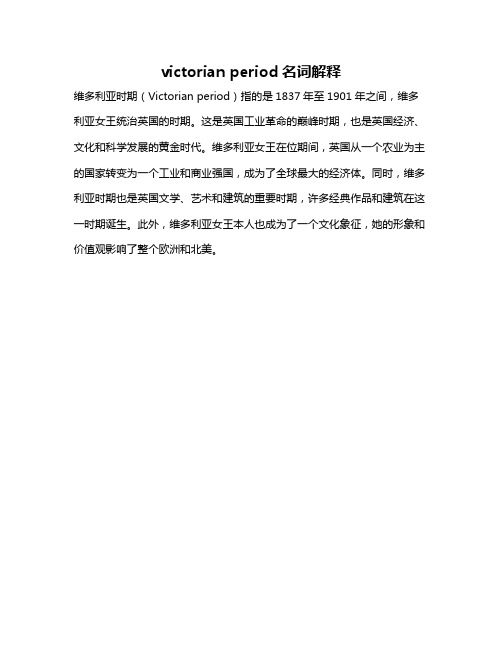
victorian period名词解释
维多利亚时期(Victorian period)指的是1837年至1901年之间,维多利亚女王统治英国的时期。
这是英国工业革命的巅峰时期,也是英国经济、文化和科学发展的黄金时代。
维多利亚女王在位期间,英国从一个农业为主的国家转变为一个工业和商业强国,成为了全球最大的经济体。
同时,维多利亚时期也是英国文学、艺术和建筑的重要时期,许多经典作品和建筑在这一时期诞生。
此外,维多利亚女王本人也成为了一个文化象征,她的形象和价值观影响了整个欧洲和北美。
英美文学选读-维多利亚时期资料
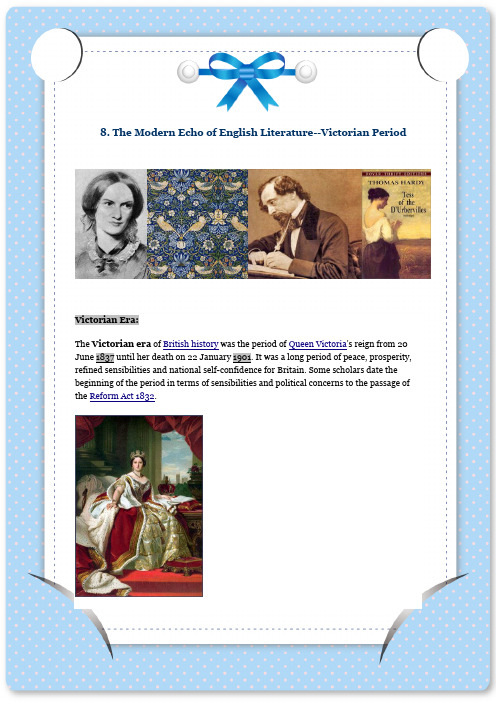
8. The Modern Echo of English Literature--Victorian PeriodVictorian Era:The Victorian era of British history was the period of Queen Victoria's reign from 20 June 1837 until her death on 22 January 1901. It was a long period of peace, prosperity, refined sensibilities and national self-confidence for Britain. Some scholars date the beginning of the period in terms of sensibilities and political concerns to the passage of the Reform Act 1832.Queen Victoria:Queen Victoria married her first cousin, Prince Albert, in 1840. Their nine children and 26 of their 34 grandchildren who survived childhood married into royal and noble families across the continent, tying them together and earning her the nickname "the grandmother of Europe".Golden Jubileejubilee ['dʒu:bli:] n.纪念或者庆典(特别指周年的)In 1887, the British Empire celebrated Victoria's Golden Jubilee.Diamond JubileeOn 23 September 1896, Victoria surpassed her grandfather George III as the longest-reigning monarch in English, Scottish, and British history. The Queen requested that any special celebrations be delayed until 1897, to coincide with her Diamond Jubilee.Movie: The Young Victoria 《年轻的维多利亚女王》Summaries•The Victorian era was a period of dramatic change that brought England to its highest point of development as a world power.•The early Victorian period (1830~48) saw the opening of Britain’s first railway and its first Reform Parliament, but it was also a time of economic distress. •Although the mid-Victorian period (1848~70) was not free of harassing problems, it was a time of prosperity, optimism, and stability.•In the later period (1870~1901) the costs of Empire became increasingly apparent, and England was confronted with growing threats to its military and economicpreeminence.•The common perception of the period is the Victorians are “prudish, hypocritical, stuffy, [and] narrow-minded”•The extreme inequities between men and women stimulated a debate about women’s roles known as The Woman Question.Literature of the Victorian Period:The drive for social advancement frequently appears in literature. This drive may take many forms. It may be primarily financial, as in Charl es Dickens’s Great Expectations 《远大前程》. It may involve marrying above one’s station, as in Charlotte Bronte’s Jane Eyre《简·爱》. It may also be intellectual or education-based. Typically, any such attempt to improve one’s social standing must be accompanied by “proper” behavior (thus helping to provide the period with its stereotype).维多利亚时期被文史家们分为三个阶段:维多利亚早期(1832~1848)、维多利亚中期(1848~1870)和维多利亚晚期(1970~1891)。
- 1、下载文档前请自行甄别文档内容的完整性,平台不提供额外的编辑、内容补充、找答案等附加服务。
- 2、"仅部分预览"的文档,不可在线预览部分如存在完整性等问题,可反馈申请退款(可完整预览的文档不适用该条件!)。
- 3、如文档侵犯您的权益,请联系客服反馈,我们会尽快为您处理(人工客服工作时间:9:00-18:30)。
After Albert died she wore black for the rest of her life.
In 1863 John Brown saved Victoria when she was involved in two carriage accidents. They became good friends, and she was so upset when he died in 1883 that she never rode a horse again.
Victoria fell in love with a man called Albert, who was German. She proposed to him in 1840 and they were married soon after.
Victoria and Albert had nine children. Victoria loved having photographs and paintings done of her with Albert and their children. Let’s look at some of them.
The was born in 1882. She had eleven brothers and sisters. When she was young she was never left alone as her mother feared she might be murdered by one of her uncles.
Queen Victoria died in 1901, when she was 83. She was buried in a white dress and her wedding veil. London was decorated in white and purple for the occasion.
In 1840 Albert died of Typhoid. Victoria was devastated as she loved Albert very much
December- 1861 (Reference the death of Prince Albert)
"Never can I forget how beautiful my darling looked lying there with his face lit up by the rising sun, his eyes unusually bright gazing as it were on unseen objects and not taking notice of me. I stood up, kissed his dear heavenly forehead and called out in a bitter agonizing cry: 'Oh! my dear darling!', and then dropped on my knees in mute, distracted despair unable to utter a word or shed a tear."
She was buried beside Albert in Windsor Castle.
Victorian Life
Victorians [who had lots of money] loved to decorate their homes with rich fabrics and very ornate furniture. They also liked to decorate the walls with paintings and photographs.
Children In Victorian Times
At the beginning of Victorian times, children without rich parents would be working, often when still very young. What they wore and what they did would not seem like childhood to us - they just did jobs they were supposedly suited to; and they wore smaller versions of the clothes adults wore, or even adult clothes cut down and rolled up to make them fit.
Many Victorians themselves realised that life was tough on working children. These pictures are typical of their sort. It's interesting that most pictures like this, published in magazines of the times, were meant to make you feel sorry for the children in the pictures... but not intended to be too realistic. They very often look far too clean!
Children of richer families would have education, and many other things, though their clothes were still mostly smaller versions of what the adults wore. By 1901, all children were legally supposed to be attending school. The Earl of Shaftsbury's reforms meant that it was illegal for young children to have to work such long hours as they had earlier. Rich children would still have education at fee paying schools. Clothes were beginning to be more different for children.
